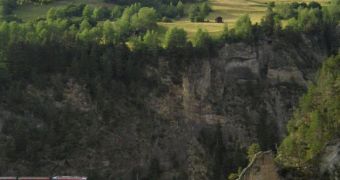One of the things the Swiss Alps are famous for is the impressive number of gorges they contain. These landscape features are monumental in scale and grandeur, and also very difficult for geologists to explain. A recent study proposes a new approach to explaining the gorges' existence.
According to researchers behind the new work, nature took a one-two punch approach to the whole situation, griding the mountains down first with glaciers, and then slicing the entire mountain chain with deep river valleys.
The Swiss portion of the Alps is marked by the fact that it contains a large number of broad glacial valleys. But the valleys in themselves are strange because they feature very steep inner gorges. For whose existence geologists had no explanation – until now.
Most of the aforementioned valleys are shaped like the letter U and so investigators proposed that, millions of years ago, glaciers were sweeping across the valley floor, eroding the bedrock.
This in turn set the stage for the rivers that replaced the glaciers when the weather got warmer. The flowing waters began carving V-shaped inner gorges in the valleys. But what researchers couldn't understand was what happened next.
Earth's ancient history is dotted with periods of global warming and cooling, so it stand to reason that some of the time, the valleys were covered by glaciers, while at other times they allowed rivers to pass through.
Geologists have been wondering whether these continuous changes are each partially responsible for a piece of the gorges, or whether the structures formed in a single geological event.
In the December 5 issue of the esteemed scientific journal Nature Geoscience, researchers say that the early gorges were able to survive from one periods of cooling to the other. The glaciers protected the fragile structures with rocks and ices, preventing them from being swept away.
“The alpine inner gorges appear to lay low and endure glacial attack. They are topographic survivors,” explains David Montgomery, a member of the research team, and an expert at the University of Washington in Seattle.
“The answer is not so simple that the glaciers always win. The river valleys can hide under the glaciers and when the glaciers melt, the rivers can go back to work,” he adds.
“That means the glaciers aren't cutting down the bedrock as fast as the rivers do. If the glaciers were keeping up, each time they'd be able to erase the notch left by the river,” Montgomery goes on to say.
“They're locked in this dance, working together to tear the mountains down,” the expert concludes, quoted by Our Amazing Planet.

 14 DAY TRIAL //
14 DAY TRIAL //